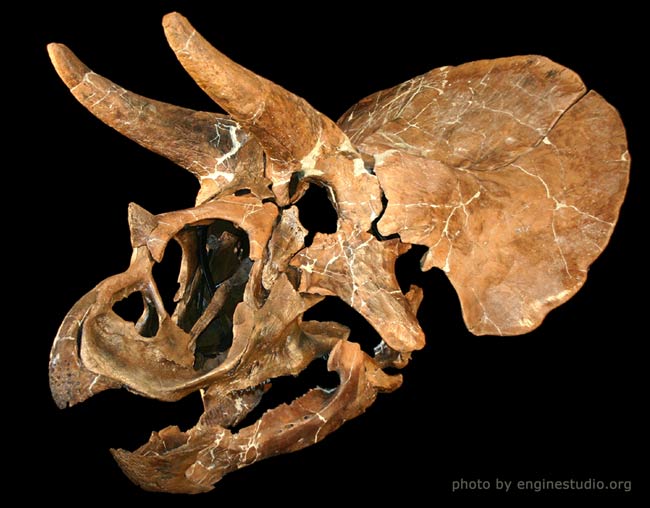Gang of Juvenile Dinosaurs Discovered

Three juvenile Triceratops, a species thought to be solitary, died together in a flood and now have been found in a 66 million-year-old bone bed in Montana, lending more evidence to the idea that teen dinosaurs were gregarious gangsters.
Triceratops were ceratopsids, herbivorous dinosaurs that lived until the the very end of the Cretaceous Period. They have been found in enormous bone beds of multiple individuals, but all known Triceratops fossils up to now have been solitary individuals. In fact, Triceratops is one of the best-known of all dinosaurs, with more than 50 total specimens discovered, so it looked pretty certain that they were anti-social and avoided hanging out with their own kind. However, the new discovery of a jumble of at least three juveniles in the famous Hell Creek Formation suggests that the three-horned Triceratops were social, or at least the juveniles were, revealing something about their behavior — a feature that is notoriously hard to discern from fossils. This news follows recent research headed up by Paul Sereno at the University of Chicago who found fossils of a bunch of juvenile ornithomimids hanging out in a group. Other researchers have found small herds of Psittacosaurus, a small cousin of Triceratops that lived in Asia.
"The pattern is that is emerging is this isn't randomness of fossilization," said Stephen Brusatte, a graduate student at Columbia University doing his studies at the American Museum of Natural History in New York. "This is a repeated pattern that probably indicates something fundamental about juvenile dinosaurs and the fact that they congregated together. We see it in all these groups of dinosaurs. Maybe not every group of dinosaurs did this, but it's something that is deep in dinosaur history. You don't see so much of it in birds and crocodiles. In dinosaurs, it seems to be something very common."
The Triceratops site was discovered in 2005 by Burpee Museum volunteer Helmuth Redschlag. Redschlag, a devoted fan of "The Simpsons" television program, named the bone bed the "Homer Site." Brusatte and colleagues soon excavated and found the multiple Triceratops, apparently gathered in a small herd. It looks like at least three juveniles died there at same time as a result of flooding, common in this location laced at the time with flood plains and river channels. "We don’t know why they were grouped together or how much time they spent together," said Joshua Mathews of the Burpee Museum of Natural History and Northern Illinois University, who led the project. "Herding together could have been for protection, and our guess is that this wasn’t something they did full-time." Excavation at the Homer Site is ongoing, and the Burpee Museum team expects to find additional fossils of Triceratops juveniles. The findings are detailed in the current issue of the Journal of Vertebrate Paleontology. Support for the project came from the Geological Society of America, the Explorers Club and other sources.
- Video: A Meal with the 'Leonardo' Dino
- A Brief History of Dinosaurs
- Gallery: Drawing Dinosaurs
Sign up for the Live Science daily newsletter now
Get the world’s most fascinating discoveries delivered straight to your inbox.
Robin Lloyd was a senior editor at Space.com and Live Science from 2007 to 2009. She holds a B.A. degree in sociology from Smith College and a Ph.D. and M.A. degree in sociology from the University of California at Santa Barbara. She is currently a freelance science writer based in New York City and a contributing editor at Scientific American, as well as an adjunct professor at New York University's Science, Health and Environmental Reporting Program.










